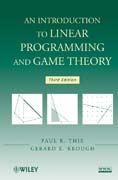
This book provides the development of the theoretical concepts and computational techniques of linear programming and game theory and explores applicationsof these topics in the social, life, and managerial sciences. The Third Edition features various additions and improvements that have been developed over the last decade, most significantly the integration of new computer software, LP Assistant, to assist the reader in learning and using the simplex algorithm,and the spreadsheet tool Solver to solve linear, non-linear, and integer programming problems. INDICE: Preface. 1. Mathematical Models. 1.1 Applying Mathematics. 1.2 TheDiet Problem. 1.3 The Prisoners Dilemma. 1.4 The Roles of Linear Programming and Game Theory. 2 The Linear Programming Model. 2. 1 History. 2.2 The Blending Model. 2.3 The Production Model. 2.4 The Transportation Model. 2.5 The Dynamic Planning Model. 2.6 Summary. 3. The Simplex Method. 3.1 The General Problem. 3.2 Linear Equations and Basic Feasible Solutions. 3.3 Introduction to the Simplex Method. 3.4 Theory of the Simplex Method. 3.5 The Simplex Tableau and Examples. 3.6 Artificial Variables. 3.7 Redundant Systems. 3.8 A Convergence Proof. 3.9 Linear Programming and Convexity. 3.10 Spreadsheet Resolution. 4. Duality. 4.1 Introduction to Duality. 4.2 Definition of the Dual Problem. 4.3 Examples and Interpretations. 4.4 The Duality Theorem. 4.5 The Complementary Slackness Theorem. 5. Sensitivity Analysis. 5.1 Examples in Sensitivity Analysis. 5.2 Matrix Representation of the Simplex Algorithm. 5.3 Changes in the Objective Function. 5.4 Addition of a New Variable. 5.5 Changes in the Constant Term Column Vector. 5.6 The Dual Simplex Algorithm. 5.7 Addition of a Constraint. 6. Integer Programming. 6.1 Introduction to Integer Programming. 6.2 Models with Integer Programming Formulations. 6.3 Gomorys Cutting Plane Algorithm. 6.4 ABranch and Bound Algorithm. 6.5 Spreadsheet Resolution. 7. The TransportationProblem. 7.1 A Distribution Problem. 7.2 The Transportation Problem. 7.3 Applications. 8. Other Topics In Linear Programming. 8.1 An Example Involving Uncertainty. 8.2 An Example with Multiple Goals. 8.3 An Example Using Decomposition. 8.4 An Example in Data Envelopment Analysis. 9. Two-Person, Zero-Sum Games.9.1 Introduction to Game Theory. 9.2 Some Principles of Decision Making in Game Theory. 9.3 Saddle Points. 9.4 Mixed Strategies. 9.5 The Fundamental Theorem. 9.6 Computational Techniques. 9.7 Games People Play. 10. Other Topics in Game Theory. 10.1 Utility Theory. 10.2 Two-person, Non-zero-Sum Games. 10.3 Noncooperative Two-Person Games. 10.4 Cooperative Two-Person Games. 10.5 The Axioms of Nash. 10.6 An Example. A Vectors and Matrices. B An Example of Cycling. CEfficiency of the Simplex Method. D LP Assistant. E Microsoft Excel and Solver. Bibliography. Solutions to Selected Problems. Index.
- ISBN: 978-0-470-23286-6
- Editorial: John Wiley & Sons
- Encuadernacion: Cartoné
- Páginas: 480
- Fecha Publicación: 31/07/2008
- Nº Volúmenes: 1
- Idioma: Inglés
